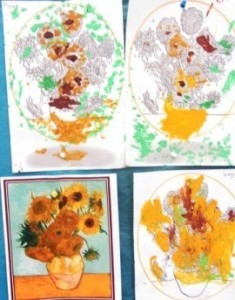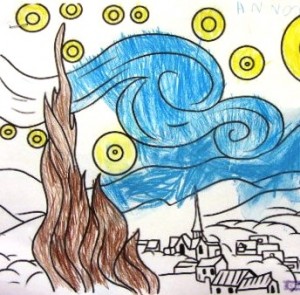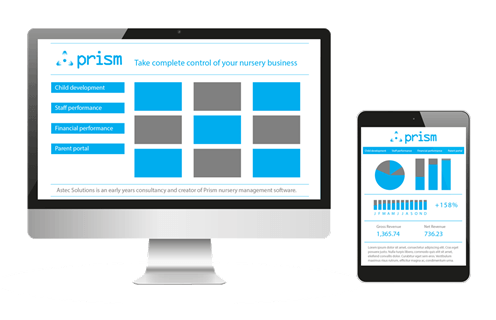When the subject of Fine Art comes up, nurseries and preschools don’t immediately spring to mind. So, when our preschool room was transformed into an art museum I was pleased to learn a few things.
Each week, I talk to our teams about their plans. Last week, my preschool team told me that they were going to do art and paintings based on some discussions which had occurred with the children. I have to say I was initially a bit dubious, but they had a good justification and, as I like to encourage staff to follow their ideas and reflect on practice, we ran with it.
What came out was totally unexpected. It showed me that we’re on the right track to developing a creative and inspiring classroom and was a great reminder to me to never to underestimate the possibilities of following a child’s interest.
Creativity to inspire
 The preschool team rose to the challenge that they had set themselves and created a number of activities and resources that enthralled the children.
The preschool team rose to the challenge that they had set themselves and created a number of activities and resources that enthralled the children.
The room was decorated in ways that created an excellent stimulus for talk and discussion. For example, pictures of people prompted discussion about what was happening, who the people were and what they were wearing. Practitioners aided the discussion with ‘possibility thinking’ questions such as “I wonder if…” and permitted children’s ideas and exploration. Sustained shared thinking was visible and children’s language, detail and ideas were evident throughout.
A conversation about the Sistine Chapel led to a discussion about how someone could paint on a ceiling. So, the practitioners put paper under the tables and let children have a go. It was a brilliant idea – a totally new way of mark making and one which enthused the class!
Learning new techniques
 Comparing and contrasting different types of art also proved valuable as children were introduced to different techniques. For example, using ‘Starry Night’ by Van Gough, was a brilliant way to teach control with mark making, by getting the children to focus on creating small lines. (I happily admit to being put to shame by one child knowing the name of the painting before I did!)
Comparing and contrasting different types of art also proved valuable as children were introduced to different techniques. For example, using ‘Starry Night’ by Van Gough, was a brilliant way to teach control with mark making, by getting the children to focus on creating small lines. (I happily admit to being put to shame by one child knowing the name of the painting before I did!)
Tracing and sketching proved particularly popular. These techniques and vocabulary are complicated, so it was really rewarding when children proudly showed me their sketches and I was told: “you can only use pencil!”
Some of the children used techniques of impressionist painters: using short, thick strokes of paint to quickly capture the essence of the subject, rather than its details. This resulted in covering Picasso with bizarre faces, much to the collective amusement.
The activities energised the whole class and the interest was such that they’re planning a trip to the local art gallery!
I’m delighted with the outcome of the experiment. The team provided activities that stimulated the classroom and provided valuable experience for the children…and for me.
Coaching to creativity
 It’s important to remember that everyone is capable of creativity. Sometimes you have to work a bit harder to create the conditions which encourage the adults in your setting be inventive. Once everyone is thinking of new ways to inspire children (linked to child interest and developmental needs), you’ll see that the extra work was well worth it. To help you on your way, here are my top three tips to inspire creativity in your classroom.
It’s important to remember that everyone is capable of creativity. Sometimes you have to work a bit harder to create the conditions which encourage the adults in your setting be inventive. Once everyone is thinking of new ways to inspire children (linked to child interest and developmental needs), you’ll see that the extra work was well worth it. To help you on your way, here are my top three tips to inspire creativity in your classroom.
1. Give your team responsibility for what happens in the room.
If your team feel involved, they’ll be more motivated and engaged and more likely to take ownership over things that they think will have a positive impact. This is a great step towards happier and engaged children.
2. Remember to accept that experiments do not always work.
When an exercise doesn’t work out as well as hoped, support your team to see it as a learning experience, not as a failure. The process is often more important than the outcome. Plan thoughtfully, have open discussions and give your team time to reflect and you’ll see positive results overall.
3. Follow a child’s interest.
You’re never quite sure what will capture a child’s interest and they can learn from a multitude of topics, experiences and ideas. Follow their lead and see where it takes you.
You never know, you might end up with a Picasso in your preschool!
Heather Stallard
Latest posts by Heather Stallard (see all)
- Vision, values & clarity - 7 January 2016
- Parental Partnerships – the conversations we’re not having - 10 November 2015
- Quality improvement in process: adopting BEEL and EEL - 13 October 2015



Brilliant! Will be trying this one.